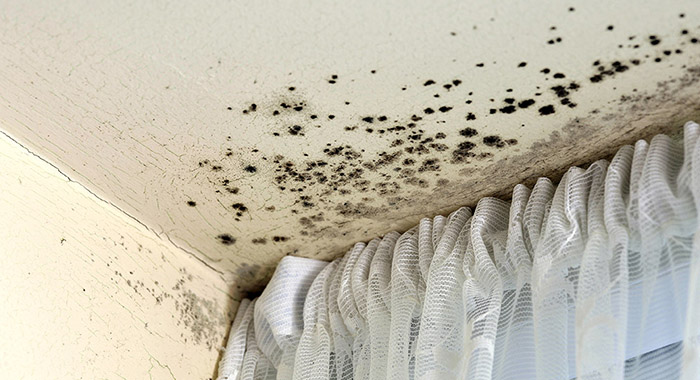By Joseph Bobb, PhD
Mould — the hidden menace quietly thriving in the depths of our living spaces. Often underestimated, this fungal adversary poses serious health risks and can significantly damage the integrity of buildings. As urban landscapes evolve and climate change heightens, an increasing number of structures are becoming susceptible to mould infestation. It is imperative that we understand the dynamics of mould growth, adopt preventive measures, and implement effective treatment strategies to safeguard our habitats.
Mould is a type of fungus that proliferates in damp conditions, feeding on organic material such as wood, paper, and drywall. It releases spores into the air, which can cause respiratory issues, allergic reactions, and other health problems. Common indoor moulds include Aspergillus, Cladosporium, and Stachybotrys chartarum, often referred to as “black mould”.
Mould is not just an eyesore; its presence indicates latent issues within a building’s structure or maintenance practices. Mould thrives in environments where moisture is prevalent. Leaky roofs, poor ventilation, condensation, and plumbing issues are prime contributors to an ideal mould habitat. Buildings in regions with high humidity are particularly vulnerable. Lack of sunlight also favours its proliferation, making basements and attics common hotspots. Understanding these conditions is the first step in effective mould management.
An ounce of prevention is worth a pound of cure
1. Moisture control: The cornerstone of mould prevention is moisture management. Fix leaks promptly and ensure proper drainage around the building. Use dehumidifiers in areas prone to high humidity and ensure that bathrooms and kitchens have functioning exhaust fans.
2. Ventilation: Improving air circulation helps to keep moisture levels in check. Regularly open windows, use fans, and consider installing ventilation systems in closed spaces, especially in newly constructed or tightly sealed buildings.
3. Building design and maintenance: A proactive approach in building design can mitigate mould risks. Opt for moisture-resistant materials and ensure roofing and plumbing systems are robust and well-maintained. Regular inspections can catch potential issues early before mould has a chance to develop.
4. Landscaping considerations: Ensure that landscaping is designed to direct water away from the building foundation. Trees and shrubs should not be planted too close, as they can obstruct airflow and trap moisture against walls.
Treatment: eradicating the unseen enemy
Once mould has set in, decisive action is required. Here is how to tackle a mould infestation:
1. Assessment and identification: Determine the extent of the problem. A thorough inspection will identify the type of mould and the source of moisture. In severe cases, it might be necessary to engage professional services for an accurate assessment.
2. Containment and removal: Isolate the affected area to prevent spore spread. Small infestations on non-porous surfaces can sometimes be cleaned with soap and water or commercial mould removers. For larger outbreaks or on porous materials, professional remediation is advisable as they have the necessary equipment and expertise.
3. Address the root cause: Treating mould without rectifying the underlying moisture issue will lead to recurrence. Ensure all leaks are repaired, and humidity levels are adequately managed before and after treatment.
4. Protection during treatment: Mould removal can release spores into the air, so protective clothing, masks, and gloves are essential. Ensure the affected area is well-ventilated during and after clean-up.
Effects on the body
Mould exposure can have a variety of effects on the human body, depending on factors such as the type of mould, the duration and intensity of exposure, and individual sensitivities or preexisting health conditions. Here are some of the key ways in which mould can affect health:
1. Respiratory Issues
— Allergic reactions: Many people experience allergic reactions to mould spores, which can manifest as sneezing, runny or stuffy nose, coughing, and itchy or watery eyes.
— Asthma exacerbation: For those with asthma, exposure to mould can trigger attacks or worsen symptoms, making breathing more difficult.
— Chronic respiratory conditions: Prolonged exposure can lead to conditions like bronchitis or other chronic respiratory issues.
2. Immune System Effects:
— Mould can impact the immune system, especially in individuals with compromised immunity or pre-existing conditions. It might increase their susceptibility to infections.
3. Skin irritations:
– Direct contact with mould can cause skin rashes or irritations, though this is less common than respiratory reactions.
4. Sinus and nasal issues:
— Mould exposure can lead to sinus congestion, headaches, and in more severe cases, sinusitis.
5. Neurological symptoms:
— Some individuals report cognitive effects such as headaches, dizziness, difficulty concentrating, and fatigue after prolonged mould exposure, though more research is needed to understand these effects fully.
6. Mycotoxicosis:
— Some moulds produce mycotoxins, toxic compounds that can cause more severe effects, such as neurological and immune system issues, when inhaled or ingested in significant amounts. However, these instances are less common.
7. Flu-like symptoms:
— Some people experience symptoms reminiscent of the flu, such as fatigue, body aches, and fever, when exposed to mould.
8. Long-term health effects:
— Chronic exposure can potentially lead to more severe health problems, particularly in individuals with prolonged exposure to toxic moulds like Stachybotrys chartarum (black mould). However, the specific long-term health effects can vary widely.
It is important to note that the severity and type of symptoms can vary significantly depending on individual susceptibility. People with allergies, asthma, or compromised immune systems are generally more vulnerable to mould-related health issues. To mitigate these health risks, it is crucial to prevent mould growth in indoor environments by controlling moisture, ensuring proper ventilation, and addressing water damage promptly. If you suspect significant or long-term exposure to mould is affecting your health, it is advisable to seek medical attention for proper diagnosis and treatment.
Conclusion: A proactive approach
As we navigate the complexities of modern living, our vigilance against mould must parallel our advancements. By prioritising prevention and enacting swift treatments, we can maintain healthier environments and preserve the longevity of our buildings. Homeowners, builders, and policymakers alike must collaborate towards innovating and adhering to standards that mitigate mould risks. In the battle against this silent intruder, informed action is our most potent weapon. Let us elevate our awareness, fortify our infrastructures, and ensure our dwellings remain safe havens, free of these insidious spores.







Lets see how many people listen to this warning.